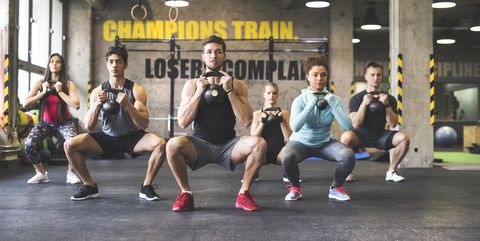
The glutes are your body’s largest and most powerful muscle group—and the key to an attractive set of assets. If you want a winning moneymaker, you should be all about the glutes.
Too many of us spend all day sitting on those muscles, however, and ignore putting extra emphasis on them in the gym for other cosmetically-appealing areas that seem more important (biceps, we’re looking at you).
But it’s not just Instagram belfie models who can benefit from some hyper-concentrated glute work. The muscles contract to move your hips in every direction, powering you up, down, forward, backward, and side-to-side. And since they’re big, working them can increase your metabolic rate.
It’s past time to give your glutes some extra TLC. Your pants will fit better, you’ll get a spring in your step, and you might just get a little extra attention when you hit the town. Add the following moves to your workout routine for a better-looking, better-performing butt.
You’ve undoubtedly seen this move on Instagram, in part because it shows off a great shot of the backside. But that doesn’t mean it doesn’t work, too—the quad hip extension is all about the big glute squeeze at the top of the movement, according to Bret Contreras, C.S.C.S., a sports biomechanist known in the fitness industry as the Glute Guy.
You can do the move just about anywhere, too, making it an easy addition to any routine.
DO IT: Get on all fours, with your spine aligned and back flat. Keep one leg firmly on the ground as you raise the other, turning your foot out slightly for an external hip rotation. Maintain your spine’s alignment and squeeze your glutes at the top of the movement. After a moment, return your knee to the ground.
To add an extra element of difficulty to quadruped hip extensions, add a miniband for more resistance, or longer pauses to accentuate the squeeze at the top of the movement.
Another Instagram favorite, the Extended-Range, Side Lying Hip Extension gives the glutes even more range to work.
“This extended range of motion off of a bench allows for a greater stretch on the hips at the bottom of the movement,” says Contreras. “The more a muscle is stretched under load the greater the potential hypertrophy (or muscle gain) stimulus.”
DO IT: Lie on a bench on your side with your knee bent, leaning on your elbow. Extend your other leg out beyond the bench. Contreras says to turn your extended foot inward for a hip internal rotation.
Raise your leg into abduction as high as you can, keeping the movement smooth and steady throughout.
Once you’re comfortable with the move, Contreras suggests adding an ankle weight to up the challenge and kickstart even more muscle growth.
Patience is the name of the game with this sumo squat variation.
You’re going to depend on tempo to maximize your work, which will ultimately allow your glutes to work even harder.
DO IT: Hold a dumbbell at waist height. Stand with your feet slightly further than shoulder width and flare them out. Plant your weight firmly on your heels and lean your torso about 30 degrees forward, which Contreras suggests should be maintained throughout the set.
Bend your knees and squat down on a four count, keeping the slight torso lean constant as you hold the weight. You should reach the bottom of the movement on four, where you’ll hold the squat position. Pause for a three count, squeezing your glutes, before standing back up to your starting point.
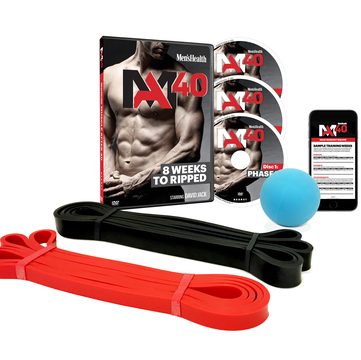
Men’s Health
MA40 Program
BUY IT HERE
Looking for a workout that will build out your glutes – as well as your arms, back, shoulders and abs? Check out MA40, an 8-week program specifically targeted for guys who want to build serious muscle.
“The setup is one of the best butt-building exercises in existence,” says BJ Gaddour, C.S.C.S., author of Men’s Health Bodyweight Muscle Burners.
It’s a motion that we perform every day—going up and down stairs and stepping on and off curbs, he says. “If you can’t properly perform it with a slow and controlled tempo, then you have no business lunging, squatting, running, or jumping.”
DO IT: Place one foot on a sturdy box or step with your weight placed on the center of your foot. Push your hips back and then stand straight up, squeezing the glute of your supporting leg at the top of the movement.
Hold this position while keeping your hips and shoulders square and your body tall. Push your hips back again, and slowly lower your trailing foot to the floor, taking 3 seconds on the way back down to the starting position.
Once you’ve perfected this pattern, you can hold a pair of dumbbells in your hands.
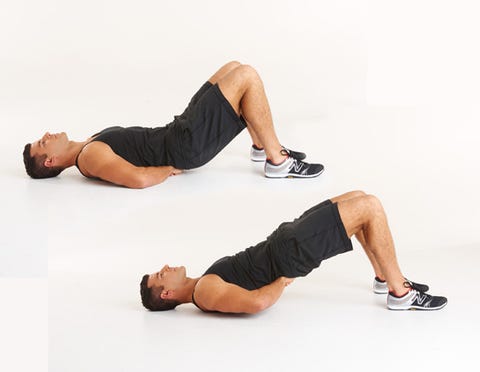
5. Hip Thrust
There’s no better way to turn on your glutes than the hip thrust. “It’s like a plank for your backside,” says Gaddour. “It’s super safe to practice and incredibly easy to learn, and you can do it anywhere, anytime.”
Gaddour recommends doing hip thrusts for at least 20 seconds for every 20 minutes that you’re in a seated position during the day.
DO IT: Lie on your back with your knees bent at 90-degree angles. Place your feet flat on the floor hip-width apart. Then crunch your abs and tilt your pelvis back so that your lower back is flat against the floor. Maintain this pelvic tilt throughout the entire exercise.
Push through your feet and raise your hips as high as you can without arching your lower back. Hold this position for a couple seconds, then slowly reverse the movement.
Make it harder by elevating your shoulders, elevating your feet, or reducing your base of support by placing your fingertips on your forehead.
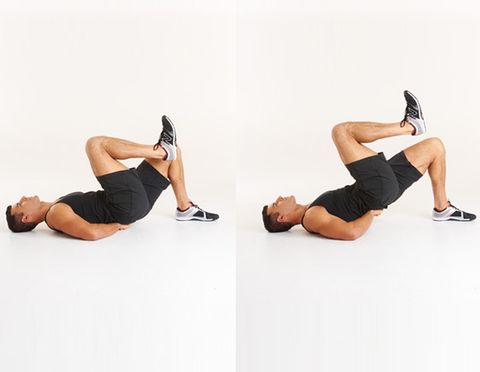
6. Single-Leg Hip Thrust
Once you’ve mastered the hip thrust on the previous slide, move on the single-leg version.
“Lifting your hips one leg at a time requires a great deal of glute stability and strength,” says Gaddour. “It will also help you iron out any strength and flexibility imbalances between sides of your glutes and hips.”
DO IT: Lie on your back with the foot of your working leg placed flat on the floor and underneath your knee so that it’s bent at a 90-degree angle. Bend the knee of your non-working leg toward your chest.
Crunch your abs and tilt your pelvis back so that your lower back is flattened against your hands or floor. Mainstain this pelvic tilt throughout the exercise.
Push through the foot on the floor and raise your hips as high as you can without arching your lower back. Pause, and then slowly reverse the movement.
The barbell hip thrust may be the king of all glute exercises, says Contreras.
“It activates the upper and lower glutes to a greater degree than any other exercise,” he explains, “and it’s known for developing a deep burn in the gluteal muscles.” Progress to this exercise after you’ve perfected the bodyweight versions on the two previous slides.
DO IT: Place your upper back against a box or bench with your knees bent and feet flat on the floor. Put a padded—the thicker the padding, the better, says Contreras—loaded barbell across your hips so your glutes are near the floor. Then squeeze your glutes and raise your hips until they’re in line with your body.
Keep your back in neutral the entire time, making sure not to arch your lower back during the movement. Return to the starting position and repeat.
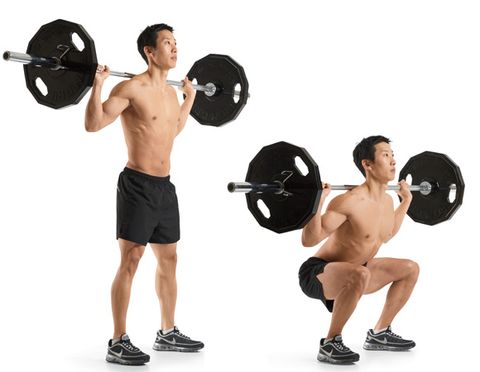
8. Barbell Squat
The back squat is generally known as a quad exercise, but it can build your backside just as well.
“As you squat, you’re stretching your glutes under load,” explains Contreras. “Then you need to produce a forceful glute contraction to propel your body ‘out of the hole’ to standing.”
DO IT: Hold a barbell across your back using an overhand grip. Keeping your head up and chest high, push your hips back, bend your knees, and lower your body until your thighs are at least parallel to the floor.
Make sure your knees track over your feet and don’t collapse inward. Push back to the starting position.
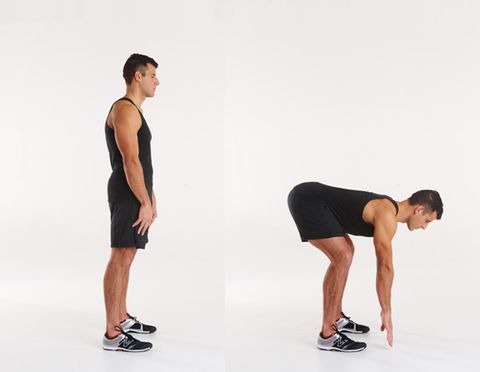
9. Hip Hinge
The better you are at the hip hinge, the better you will be at every lower-body exercise. Squats, lunges, deadlifts, jumps, and stepups all start by hinging back at your hips, preloading your glutes and hamstrings, says Gaddour.
The key to hip hinging is little to no movement at the knee and lower back. You are only moving at the hips, keeping your spine neutral.
DO IT: Stand with your feet hip-width apart. Set your head in a neutral position with your ears aligned with your shoulders, hips, and ankles, and maintain this position as you hint back and bend forward.
Keep your knees soft with a slight bend, and push your hips and hamstrings back as far as you can until your torso is parallel to the floor. Picture yourself closing a door with your butt.
Pause, and then push your hips forward and come to a full stand. Squeeze your glutes at the top of the movement.
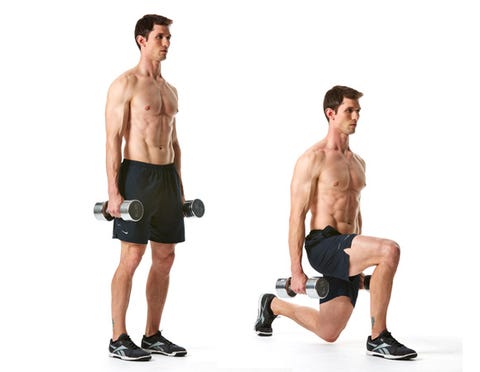
10. Walking Dumbbell Lunge
As you sink down into the lunge, the hips on your lead leg must deeply bend, explains Contreras. This stretches your glutes and places a high load on them at the most difficult part of the movement. That’s why the walking dumbbell has a nasty reputation for preventing people from sitting down the next day, he says.
DO IT: Stand holding a pair of dumbbells and take a long step forward with your left foot. Push up into a standing position, bringing your back foot forward. That’s 1 rep.
Alternate the leg you step forward with so that you’re “walking” with each rep.
The deadlift works the entire backside of your body. Do it right, and it’ll help you build stronger, more sculpted butt, says Contreras.
“That’s because the hip hinge—which is a prerequisite to proper deadlifting mechanics—is completely carried out by the glutes and hamstrings,” he says. (See the previous slide for a description of the hip hinge.)
DO IT: Load a barbell and roll it against your shins. Bend at your hips and knees and grab the bar with an overhand grip, your hands just beyond shoulder width.
Keeping your lower back naturally arched, pull your torso up and thrust your hips forward as you stand up with the barbell. Lower the bar to the floor and repeat.
“When you lock out the weight at the top of the movement, make sure to squeeze your glutes,” says Contreras. “This will help push your hips forward so you can lift more weight.”
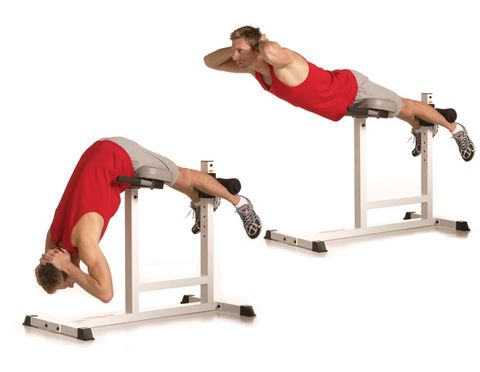
12. Back Extension
You may perform back extensions for your lower back, but the movement can be altered to target your butt muscles, according to Contreras.
By turning your feet outward at a 45-degree angle, you shift the load to your glutes, he says. Make sure you are fully contracting your backside by squeezing your glutes at the top of the movement every rep.
DO IT: Hook your heels into a back extension station, turning your toes away from each other so that your feet are at 45-degree angles from your calves.
Keeping your back naturally arched, lower your torso until your body is bent 90 degrees. Then raise your torso back up until it’s in line with your lower body, squeezing your glutes.

13. Single-Leg Straight-Leg Deadlift
This exercise improves your single-leg balance and targets the muscles of your glutes and hamstrings.
“As you perform this move, your hips will try to rotate away from your working leg and the toes of your nonworking leg will point out to the side,” says Gaddour. “You can prevent this by squeezing the glute of your nonworking leg throughout the exercise. This will lock your hips into place.”
Don’t get frustrated: The single-leg straight-leg deadlift is tricky since there’s a big balance component involved. Start with no weights, and then progress to dumbbells or a barbell once you master the movement.
DO IT: Grab a barbell with an overhand grip that’s just beyond shoulder width and hold it at arm’s length in front of your hips. Establish a tripod position with your front foot, keeping your knee soft with a slight bend.
Screw the foot of your working leg into the floor and squeeze the glute of your trailing leg to keep your hips square. Push your hips and hamstrings back as far as you can, lifting your back leg off the floor as you do so.
Your torso should be parallel to the floor with a slight natural arch in your lower back. Pause, and then push your hips forward and come to a full stand, squeezing your glutes at the top.
The Bulgarian split squat activates your quadriceps and builds single-leg stability.
“And as you lower, the movement causes tiny tears in your glutes,” explains Contreras. “Over the next couple days, your body repairs these microtears, making your muscles fibers stronger and bigger than before.”
DO IT: Stand a couple of feet from a bench or step, with your back to the seat. Bend your right leg and place the top of your right foot on the bench as you place your hands behind your head. This is the starting position.
Keeping your torso upright, bend your left leg and lower your body until your left leg is bent at least 90 degrees. Push your body back to the starting position.

15. Cable Kickback
If you want a round, hard butt, you can’t skip this move. “Many gymgoers mistakenly label the cable kickback as a ‘wussy exercise,’ but that’s a mistake,” says Contreras. The movement zeroes in on the gluteus maximus, which is the muscle that creates the shape of your rear end.
DO IT:Lower the arm of a cable machine so it’s level with your ankle. Stand facing the machine with your feet hip-width apart. Put one foot through the cable handle. Keeping your chest lifted, use your glute to pull the foot with the cable directly behind you.
Don’t let your back arch. Pause, and then slowly return your foot to the starting position. Do your reps with your weaker side before switching legs and performing the same number with your stronger side.

16. Cable Standing Hip Abduction
“The cable standing hip abduction hits your upper glutes muscles, which are often neglected by most guys,” says Contreras. “The stronger they are, the stronger and more sculpted your backside.”
DO IT: Lower the arm of a cable machine so it’s level with your ankle. Stand with one side closest to the cable machine and that foot just behind the cable. Loop your other foot through the handle, and use your glutes to pull that leg out to your side. Pause, and reverse the movement to the starting position.
Perform your reps with your weaker side before switching legs and performing the same number with your stronger side.
This movement hammers your backside, working your hamstrings and glutes explosively, says Contreras. That means you’ll target your fast-twitch muscle fibers—the ones that weaken with age and that are crucial in almost every activity that you do.
To fully activate your glutes, keep your back in a neutral position and squeeze your butt at the top of the movement, explains Contreras.
DO IT: Bend at your hips and hold a kettlebell with both hands at arms length down in front of you. Rock back slightly and “hike” the kettlebell between your legs.
Then squeeze your glutes, thrust your hips forward forcefully, and swing the weight to shoulder height. Reverse the move between your legs and repeat.

18. Lateral Mini-Band Walk
A miniband might not be one of the first tools you reach for when building a stronger, more powerful backside, but it should be.
“When placed around the tops of your shins as you move side to side, the miniband hits your hand-to-reach gluteus medius, a muscle that helps rotate your thigh inward and outward,” says Nick Murtha, a trainer for Men’s Health Thrive. Waking up this muscle allows you to use all your glute strength when performing moves like a heavy-loaded squat or lunge, he says.
DO IT: Place both feet inside a miniband. With your feet just beyond shoulder-width, place the band at the top of your shins, right above your ankles, or around the balls of your feet.
Maintaining the distance between your feet, create a square by taking small, short steps. Take 8 side steps to your left, 8 steps forward, 8 side steps to your right, and 8 steps backward.
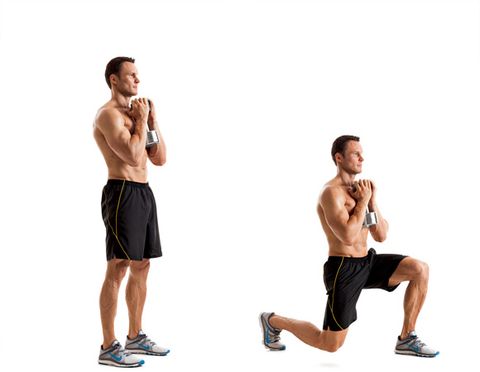
19. Goblet Reverse Lunge
This exercise targets your gluteus maximus, your butt’s main muscle. Done often, it’ll help lift your butt so it no longer droops. “Since it’s the largest muscle in your backside, targeting it will also help you make greater gains in size and strength,” says Contreras.
DO IT: Cup the head of a dumbbell in both hands and hold it vertically in front of your chest, elbows pointing down. Step back with your right leg and lower your body until your front knee is bent 90 degrees.
Pause, and then push your body back to standing. Do all your reps on one side before switching legs and doing the same number on the other side.

20. Clamshell
This exercise targets your hip abductors, primarily a muscle called the gluteus medius. This muscle assists your largest butt muscle—your gluteus maximus—in raising your thigh out to the side. It also rotates your thigh outward when your leg is straight, and inward when your hip is bent.
As the name suggests, think of a clamshell opening as you do the exercise. Your glute should do all the work, so keep the rest of your body completely still as you left and lower your leg.
DO IT: Lie on your side with your knees bent 90 degrees and your heels together and in line with your butt. Open your knees as far as you can, without rotating your pelvis or back. Pause; return to the starting position.

Source: Read Full Article
